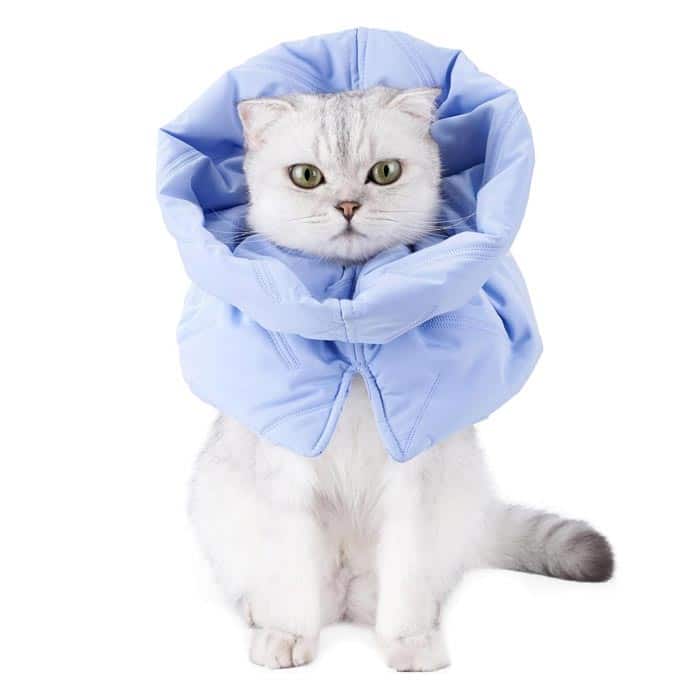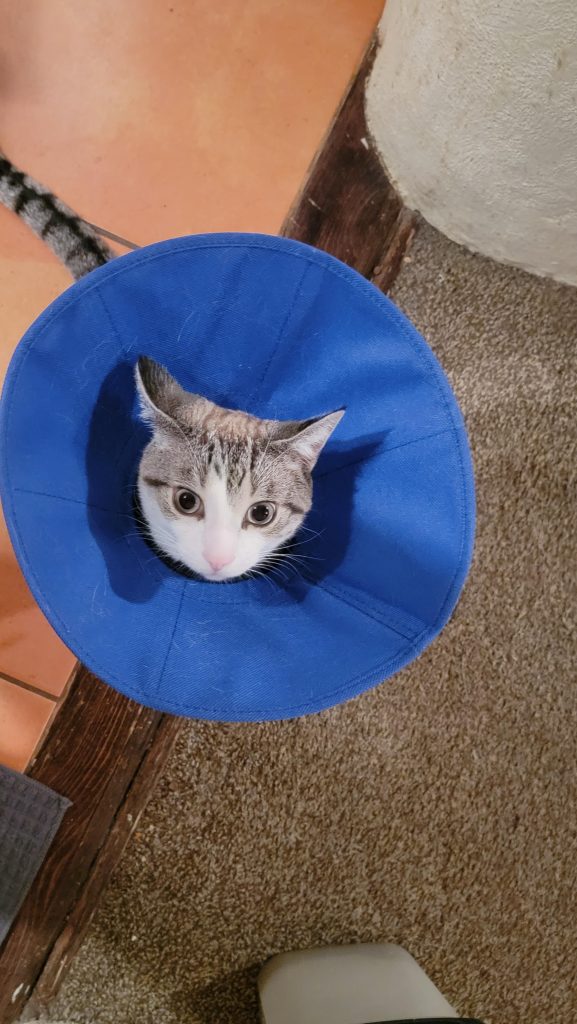Keeping an Elizabethan collar, or “e-collar,” on your cat can feel like an uphill battle. You know it’s vital for their healing, but your feline friend may see it as an uncomfortable nuisance.
If you’ve ever struggled with a cat that wriggles, squirms, or simply seems to outsmart the collar, you’re not alone. You’re about to discover clever tips and tricks to ensure your cat wears their e-collar comfortably and safely. Imagine the peace of mind you’ll have, knowing your cat is healing properly without the constant worry of them ditching the collar.
Ready to turn the struggle into success? Let’s dive in and explore how you can make this challenging time a little easier for both you and your furry companion.

Credit: www.lillyandmax.com
Choosing The Right Collar
Choosing the right Elizabethan collar is key to keeping your cat safe and comfortable. The right collar stops your cat from licking wounds or stitches. It should fit well without hurting or stressing your pet. Picking the right type and size helps your cat adjust faster. This section explains how to choose the best collar for your cat’s needs.
Types Of Elizabethan Collars
- Plastic Cone:The classic, rigid cone. It offers strong protection.
- Soft Collar:Made from fabric or foam. More comfortable but less sturdy.
- Inflatable Collar:Looks like a neck pillow. Limits neck movement gently.
- Adjustable Collars:Can be resized. Fits growing or different-shaped cats.
Each type has benefits and drawbacks. Consider your cat’s behavior and injury type.
Sizing For Comfort And Safety
Measure your cat’s neck carefully for the right collar size. The collar should be snug but not tight. Leave space for two fingers between the collar and neck. The collar length must extend past the cat’s nose. This stops your cat from reaching wounds.
Too large collars cause tripping and stress. Too small collars can choke or irritate. Check the fit regularly as your cat moves or grows. Choose collars with adjustable straps for a better fit.
Preparing Your Cat
Preparing your cat to wear an Elizabethan collar is key to a smoother experience for both of you. Cats are sensitive creatures who may resist anything new around their neck. Taking time to get your feline friend comfortable before actually putting on the collar can reduce stress and prevent frantic attempts to remove it.
Familiarizing Your Cat With The Collar
Start by placing the collar near your cat’s favorite resting spot or play area. Let them sniff and explore it without pressure. You might notice your cat pawing at it or even rubbing against it out of curiosity.
Try holding the collar up to your cat’s neck briefly, then remove it before they get upset. Repeat this a few times over several days. This gradual exposure helps your cat accept the collar as part of their environment instead of something to fear.
Using Positive Reinforcement
Reward your cat with treats, gentle petting, or play whenever they interact calmly with the collar. This creates a positive association that can ease future acceptance. Speak softly and stay calm to reassure your cat throughout the process.
If your cat wears the collar even for a short time, celebrate the small win with extra affection or their favorite snack. Have you tried pairing collar time with a special activity your cat enjoys? This can shift their focus and make the collar feel less like a burden.
Proper Collar Fitting
Proper collar fitting is crucial to keep your cat comfortable and safe while wearing an Elizabethan collar. A collar that fits well prevents your cat from slipping out and reduces stress. It also helps avoid irritation around the neck, making the healing process smoother for your furry friend.
Adjusting Straps And Fasteners
Start by loosening all straps and fasteners before placing the collar on your cat. This gives you room to adjust the fit without causing discomfort. After positioning the collar, gently tighten the straps so that the collar sits snugly but not too tight around your cat’s neck.
Check that the fasteners are secure but easy for you to open when needed. Velcro straps often provide flexible adjustment, while buckles offer a more secure hold. If the collar feels too loose, your cat might slip out, but if it’s too tight, it can restrict breathing or cause chafing.
Checking For Secure Fit
Once adjusted, test the fit by sliding two fingers between the collar and your cat’s neck. This simple check ensures the collar isn’t choking or too loose. If you can’t fit two fingers comfortably, loosen the straps a bit.
Observe your cat’s behavior after fitting the collar. Is your cat able to eat, drink, and move without excessive struggle? If not, you might need to adjust the fit or try a different collar size. Remember, a collar that’s too tight or too loose can lead to frustration and injury.
Managing Cat Behavior
Managing cat behavior while your pet wears an Elizabethan collar is important. Cats often resist wearing these collars due to discomfort or unfamiliarity. Understanding their behavior helps keep the collar on and reduces stress for your cat. Patience and gentle care are key.
Preventing Collar Removal
- Check the collar fit regularly; it should be snug but not tight.
- Use soft padding around the collar edges to prevent irritation.
- Distract your cat with toys or treats to reduce focus on the collar.
- Limit unsupervised time during the first days of collar use.
- Keep the collar clean and dry to avoid discomfort.
- Observe your cat often to stop any attempts to bite or scratch the collar.
Keeping Your Cat Calm And Comfortable
Create a quiet, cozy space for rest away from noise and activity. Soft bedding helps your cat relax while adjusting to the collar.
Offer regular affection and gentle petting to ease anxiety. Speak in a soft voice to comfort your cat.
Maintain normal feeding and play schedules to provide a sense of routine. Use interactive toys to divert attention from the collar.
Monitor your cat’s behavior for signs of stress or frustration. Consult a vet if your cat seems overly distressed or refuses to eat.
Maintenance And Monitoring
Keeping an Elizabethan collar on your cat means more than just putting it on. You must maintain and monitor the collar regularly to ensure your cat stays safe and comfortable. Neglecting this part can cause irritation or even injury, so it’s vital to check and clean the collar often.
Regular Collar Inspections
Check the collar several times a day to make sure it fits snugly but isn’t too tight. Look for any signs of rubbing, redness, or swelling around your cat’s neck. If you spot any irritation, adjust the collar immediately or consider a different size or style.
Also, watch how your cat moves with the collar on. Does it seem stuck or overly restricted? If your cat struggles to eat or drink, you might need to trim the collar or switch to a softer material. Have you noticed your cat pawing at the collar more than usual? That could mean discomfort or a poor fit.
Cleaning The Elizabethan Collar
Keep the collar clean to avoid infections and bad smells. Use a damp cloth with mild soap to wipe down the collar daily, especially if your cat has been outside or eating messy food. Rinse thoroughly and dry before putting it back on.
Some collars are washable, so check the care instructions. If yours is machine washable, use a gentle cycle and avoid harsh detergents. Remember, a clean collar helps your cat feel better and encourages them to keep it on without fuss.

Credit: www.reddit.com
Alternatives To Traditional Collars
Traditional Elizabethan collars can be uncomfortable for cats. Some cats resist wearing them. Alternatives offer comfort and protection. These options help cats heal without stress.
Soft Collars And Inflatable Options
Soft collars are made from flexible materials. They allow more movement than hard plastic collars. Cats find them less annoying. Inflatable collars work like small neck pillows. They prevent cats from reaching wounds but feel less bulky. Both types reduce noise and bumping into objects. These collars suit calm cats who dislike hard barriers.
Using Medical Pet Clothing
Medical pet clothing covers wounds without restricting head movement. These garments are soft and stretchy. They stop cats from licking or scratching injured areas. Clothing comes in various sizes and styles. Some have openings for bandages or drains. They keep cats warm and comfortable. Medical clothing is a good choice for cats that reject collars.

Credit: www.reddit.com
Frequently Asked Questions
How Do I Keep An Elizabethan Collar On My Cat?
Ensure the collar fits snugly but comfortably around your cat’s neck. Secure the fasteners properly. Supervise your cat to prevent removal. Offer treats to encourage acceptance.
Why Does My Cat Try To Remove The Elizabethan Collar?
Cats feel uncomfortable and restricted by the collar. They may scratch or rub it off. Providing distractions and positive reinforcement helps them adjust and keep it on.
How Long Should A Cat Wear An Elizabethan Collar?
Typically, cats wear the collar until wounds heal or stitches are removed. This usually takes 7 to 14 days, but follow your vet’s advice for the best duration.
Can I Make My Cat More Comfortable With The Collar?
Yes, choose lightweight collars and check for irritation regularly. Provide a calm environment and use treats to ease stress. Adjust collar fit if needed for comfort.
Conclusion
Keeping an Elizabethan collar on a cat can be tricky but doable. Patience helps a lot during this process. Make sure the collar fits well and is comfortable. Offer treats and gentle praise to your cat. Check the collar often to avoid irritation or damage.
Keep your cat busy with toys and attention. Remember, the collar protects your cat’s healing. With care and kindness, your cat will adjust soon. Stay calm and consistent for the best results. Your effort helps your cat stay safe and healthy.

